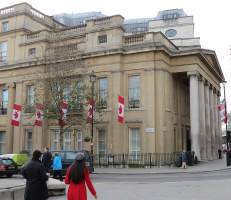 Portico of Canada House, by Robert Smirke.
Portico of Canada House, by Robert Smirke.
The short street leading westwards out of the southern side of Trafalgar Square is Cockspur Street; together with the road out of the top of the square, which is Pall Mall East, it marks off a triangular site, with the massive building housing the Canadian embassy filling the Trafalgar Square side. The south side of Cockspur Street has a short series of buildings with sculptural interest of greater or lesser significance, most notably Norway House and the P&O Building, and at the end is a worthy equestrian statue of George III.
 Portico of Canada House, by Robert Smirke.
Portico of Canada House, by Robert Smirke.
We start with Canada House. This building, rather battered by modern changes, is still recognisable as the one-time College of Physicians. That institution had had a building near to St Pauls Cathedral in the time of Charles I, with a statue, to Harvey, who discovered the circulation of the blood. After that was destroyed by fire in 1670, Wren designed a new building, which had two statues, one of Charles II, and the other of a benefactor, Sir John Cutler, who afterwards was found not to be able to pay his promised benefaction. The current building, occupying the whole of the western side of Trafalgar Square, was designed by Robert Smirke, architect of the British Museum. It retains the original giant ionic portico to both north and south sides – the latter being the one to Cockspur Street.
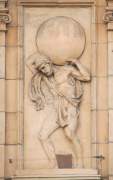
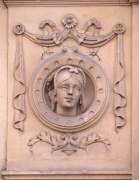
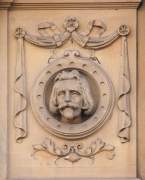 Terra cotta Atlas relief sculpture, roundel heads.
Terra cotta Atlas relief sculpture, roundel heads.
We walk along the Canada House (north) side of Cockspur Street to appreciate the buildings on the south side. The first building of interest is a flat-fronted building clad in Doulton terra cotta, no.26-27 Cockspur Street, with rows of rather squarish windows, with minor terra cotta adornments including a central Atlas figure in relief, standing, supporting a globe on his bowed shoulders. Other panels include globes on stands, and cartouches with coats of arms. It was designed by the architect W. B. Williams as the premises for Stanford's, the specialist purveyor of maps, hence the geographical symbolism. Adjacent is a narrow building with the same elevations, lightly inscribed surface decoration, and two roundels with heads: a young woman with headpiece, and a bewhiskered man of vaguely historic appearance and in light-hearted vein. Other minor decoration on this building includes keystone heads, festoons, and interesting pillars.
Norway House, King Olav Statue, Figure Panels by Roselieb.
Norway House, refronted by the architects Goldsmith and Westbye to make a grand 1920s facade on a building put up at the beginning of WW1. The edifice is five bays wide, with granite faced ground floor, stone above, and two modern-looking dormer levels which detract from the top. The sculptural adornment consists of a standing figure above the main entrance, four figure panels a floor above that, and a panel in a central open pediment two storeys above that. The standing figure is St Olav of Norway, with the saint standing in a symmetrical pose wearing armour and helm, his hands on the hilt of his down-pointing sword, and a wide cloak held below the neck, spreading out to reveal a prominent cross on his chest. Below the figure, a shield with rampant lion holding an axe, and surmounted by a crown. The four figure panels, from the original decoration of the building, are the work of the sculptor L. F. Roselieb, who produced a number of rather similar architectural carvings elsewhere. We see an Industry (female, back turned to us, factory in background), Commerce perhaps (Mercury figure, holding globe and aesculapeian staff, ship above, corn below; Finance or Trade (male figure weighing coinage and holding a money bag, frieze of Egyptian and Assyrian traders above); and Travel (female figure holding a steam train, with panel of steamships above, part-hidden globe below. The male figures are nude, the females semidraped; all are extremely muscular, in a hard early 20th Century idiom rather than approaching the Victorian or Greek ideal. (For lots of allegorical sculpture, see this page and pages linked to it.)
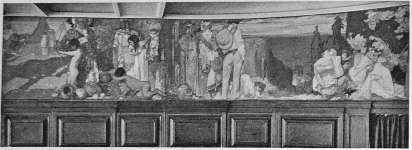
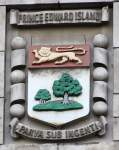 Brangwyn mural and one of the coats of arms of Canadian provinces.
Brangwyn mural and one of the coats of arms of Canadian provinces.
It is nice to see this building so close to Canada House, and the Canadian Pacific Building on the south side of Trafalgar Square, giving us a little Canadian enclave in the heart of the West End (for other Canadian interest, a short walk along the Mall takes us to the Queen Victoria Memorial with its Canada Gate (see bottom of this page), and a few steps just beyond, by the entrance of Green Park, is the modern Canadian War Memorial). The building is six stories high plus dormers, with the double height ground floor consisting of an entrance flanked by two very wide arched windows, and the floors above being of six windows each. It is a work of the architect Aston Webb, and includes high relief panels showing the coats of arms of the different Canadian provinces. These are painted and rather nicely done, especially New Brunswick’s ship and Prince Edward Island’s trees, and the chunky little heraldic beasts for Newfoundland. Frank Brangwyn made interior friezes in tempera showing European colonists and fierce Red Indian chiefs in typical lively style, and Alfred Drury made a charming frieze showing cherubs holding a ship and a steam train.
Doorway caryatids by Richard Goulden, and W. B. Fagan's allegorical figures of Germany and America.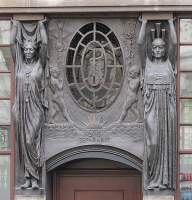
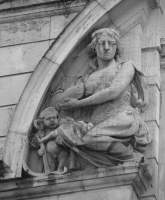
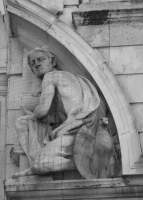
The P&O Line Building is a large, stone-clad structure of four bays with sculptured friezes and two attached figures high up on the second bay from the right. Dating from 1908, this building, nos. 14-16 Cockspur Street, is the work of the architects Arthur T. Bolton, and Stock, Page and Stock. It was built as the Hamburg-Amerika Linie Building (sic), with interior modelling in plaster to represent the Continents by Schacht and casting by Aubrey. The nine Portland Stone bas-relief panels are the work of the sculptor William B. Fagan, a rather obscure figure of mixed abilities, one time pupil of W. S. Frith. As befitted a steamship company, the subjects are classical travel stories. Above are two large attached figures, again by Fagan, representing Germany and America. The female figure is a solidly built warrior female, ascribed to be Germany (though I have been unable to confirm this), so some sort of a Rhine maiden, with strong features, a powerful neck, statuesque build and with her upper garment looking more like plate armour than cloth (if you like this, see other statues of warrior women on this page) – a rare allegorical statue of Germany in Britain. She holds one of the company’s ships, and underneath lurks a grim cherub holding an anchor. The companion figure, by elimination America, is not a flattering depiction of that country, for although we see a powerful youth, again holding a ship, his face is set in almost a sneer, and he is accompanied by a fierce eagle. The suspicion lurks that this figure could as easily be Germany with a German eagle rather than an American one, and the female then would be America.
Sculptured reliefs of Apollo, perhaps, Europa, and Icarus.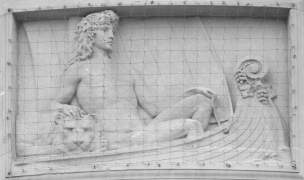
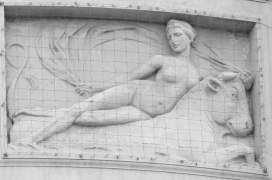
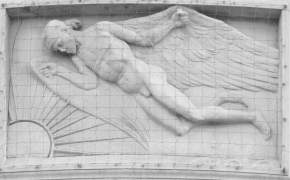
The figures are in curved spandrels or side arches to an arched window, with above, a large Baroque superstructure and pediment, with further sculpture: a great bearded keystone with some long winged bird disturbingly hanging down from the beard, and to the sides, a mermaid and merman with looped tails. Below the window is a balcony, with a projecting ship’s prow with a very small, worn double-tailed mermaid as figurehead (for comparison, see pages on this site on keystones and mermaids). Somewhat beneath this, parallel with the groups of panels on the other three bays, is a head of a Mercury, with clasped hands and a disconcertingly disembodied pair of wings.
The nine panels are worth a look looking at with some magnification. There are three on each of the three subsidiary bays, each consisting of a central character, with the two flanking panels showing boys on dolphins and hippogryphs. The central panels depict a nude Europa reclining on her bull, an equally unclad male figure (Apollo? Young Bacchus?) in a sailing boat resting his hand on a lion’s head, and Icarus flying too near the sun, thus about to plunge into the ocean. The Europa is the most satisfactory of these, and the flanking fierce dolphins and hippogryphs are also well represented.
On the ground floor, the principal entrance is not underneath the attached figures, but on the next bay along to the left. Above this entrance are two bronze figures. The original sculptures were by J. Wenlock Rollins. However, when after WW1 the building passed into the ownership of the Pacific and Oriental Line, this doorway was replaced with the present figures, excellent examples of Caryatids. I understand them to be by Reginald Goulden, but have not noticed the signature. It must have been at this time that the P&O monogram was carved into panels across the front of the building.
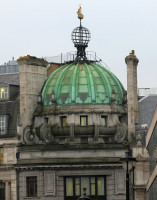
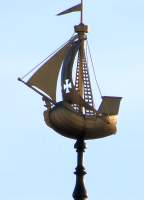
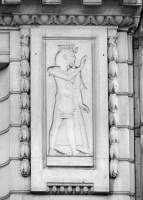 Facing Haymarket; dome, ship weathervane and Egyptian panel.
Facing Haymarket; dome, ship weathervane and Egyptian panel.
Finally, we may note the building next to the P&O Building, which faces up Haymarket. We have to walk a little way up Haymarket to see it, but it has on top a green dome, on which is a hollow sphere borne up by four caryatid boys, rather in the manner of Frank Matcham’s ENO (again, see page on Caryatids). Held atop the globe is a model of a ship, rather like a weathervane. Also on the front of this building are two panels, identical, depicting ancient Egyptians.
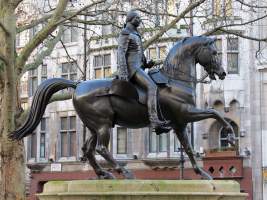
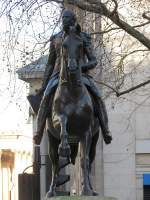 Two views of George III, by M. C. Wyatt.
Two views of George III, by M. C. Wyatt.
The statue of George III, in the little open space where Cockspur Street meets Pall Mall East, feels a little out of the way, compared to the statues in Trafalgar Square just a few paces away, which are seen by so many passers by each day. It was not intended for this place, but for Waterloo Place, except that the the statue of the Duke of York, George III’s son, stands there on his column, and as that statue faces away from the Place, it was thought improper that the father’s statue should have the back turned to him by the son.
Nor was the statue intended to be as it is – originally it was proposed by the sculptor, Matthew Cotes Wyatt, to have the king seated in a triumphal carriage, drawn by four horses. But the amount of funding was insufficient, and so the equestrian statue came to be. It was however greeted with much satisfaction: ‘As a work of art, this magnificent group is of high merit. It is a faithful representation of George the Third, mounted upon her favourite charger, which is very finely modelled. The King looks down Pall Mall towards St James’s, and holds in his hand a cocked hat.’ Sir Frederick Trench, a member of the responsible Committee, who gave a speech at the unveiling of the statue in 1836, was of the view that it would ‘immortalise the artist who has executed it’.
An account of this statue written in the 1880s however wrote that:
Although the likeness of the king is good, the statue is not generally admired, on account of its costume; and the pigtail at the back of the royal head has often been made the subject of waggish and uncomplimentary remarks. Altogether, it can hardly be said that this statue is calculated to raise the credit of English sculpture in the eyes of foreign visitors.
Several views of this statue are on the Horse statues for drawing page.
Looking back along facades of Cockspur Street.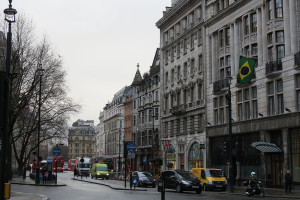
East to Trafalgar Square // West to Waterloo Place // North to Leicester Square // North West to Piccadilly Circus
London sculpture // Sculpture pages
Visits to this page from 10 Jan 2013: 12,395